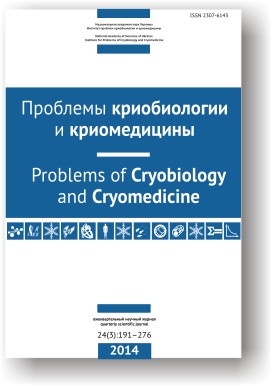ИÑпользование оÑобенноÑтей Ñпектров ÐПРионов переходных металлов при иÑÑледовании ÐºÐ¾Ð½Ñ†ÐµÐ½Ñ‚Ñ€Ð¸Ñ€Ð¾Ð²Ð°Ð½Ð¸Ñ Ñолей в завиÑимоÑти от уÑловий замораживаниÑ
DOI:
https://doi.org/10.15407/cryo24.03.212Ключові слова:
заморожуваннÑ, гіперконцентруваннÑ, електронний парамагнітний резонанÑ, Ñпін-гамільтоніан, Ñтруктура ÑпектрівАнотація
ДоÑліджено Ñпектри ЕПРзаморожених розчинів Ñолей парамагнітних катіонів. Показано, що Ñтруктура й форма Ñпектрів залежать від режиму та Ñкладу Ñередовища заморожуваннÑ. Отримані екÑпериментальні Ñпектри ЕПРтеоретично опиÑані Ñпіновими гамільтоніаном, Ñкий міÑтить акÑіально-Ñиметричний терм тонкої Ñтруктури з проÑвом заборонених Δm = ±1 переходів. Запропоновано викориÑтовувати підходи ЕПРпри розробці низькотемпературних технологій конÑÐµÑ€Ð²ÑƒÐ²Ð°Ð½Ð½Ñ Ð±Ñ–Ð¾Ð»Ð¾Ð³Ñ–Ñ‡Ð½Ð¸Ñ… об'єктів Ð´Ð»Ñ Ð°Ð½Ð°Ð»Ñ–Ð·Ñƒ режимів Ð·Ð°Ð¼Ð¾Ñ€Ð¾Ð¶ÑƒÐ²Ð°Ð½Ð½Ñ Ð¹ можливих кріопротекторів із метою Ð¿Ñ€Ð¾Ð³Ð½Ð¾Ð·ÑƒÐ²Ð°Ð½Ð½Ñ Ð¼Ñ–Ð½Ñ–Ð¼Ñ–Ð·Ð°Ñ†Ñ–Ñ— ефектів кріопошкоджень виÑокими концентраціÑми Ñолей при заморожуванні.Посилання
Allen B.T. Zero-field splitting parameter of Mn++ ion glassy and in polycrystalline media. J Chem Phys 1964; 43(11): 3820–3826.
Allen B.T., Nebert D.W. Hyperfine structure in EPR spectrum of the manganous ion in frozen solutions. J Chem Phys 1964; 41(7): 1983–1985. CrossRef
Garifianov N.S., Timerov R.Kh., Usacheva N.F. EPR in Mn2+ and Gd3+ ions-contained overcooled solutions. Fizika Tverdogo Tela 1962; 4(11): 3344–3345.
Gataullin A.M. Combined relaxation control of contrast substances for magnetic tomography [dissertation]. Kazan; 2004.
Gordienko E.A., Pushkar N.S. Physical grounds of low temperature preservation of cell suspensions. Kiev: Naukova dumka; 1994.
Katyukhin V.A. Study of the process and design of the equipment for obtaining frozen granules from fluid foods [dissertation]. Moscow; 1973.
Larin G.M., Shulgin V.F., Melnikova E.D et al. Study by EPR method of weak exchange interactions in copper (II) binuclear complexes with acyldihydrazones of fluorated b-diketones. Bull Rus Acad Sci. Chemistry series 2002; (4): 585–589.
Lovelock J.I. The haemolysis of human red blood cells by freezing and thawing. Biochim Biophys Acta 1953; 10(4): 414–420.
Lovelock J.I. The denaturation of lipid/protein complexes as cause of damage by freezing. Proc Roy Soc Ser 1957; 147(4): 427–433.
Mazur P. Physical and chemical basis of injury in single celled microorganisms subjected to freezing and thawing. In: G.L. Rapartz, L.J. Menz, B.J. Luyet, H.T. Meryman, editors. Cryobiology. New York: Academic Press; 1966.p. 213–315.
Mazur P. Kinetics of water loss from cells at sub-zero temperatures and the likelihood of intracellular freezing. J Gen Physiol 1963; 47(2): 347–369. CrossRef PubMed
Mazur P., Leibo S, P., Chu E. H. Y. A two-factor hypothesis of injury. Exp Cell Res 1972; 71(2): 345–355. CrossRef
Moiseyev V.A., Nardid O.A., Belous A.M. On a possible mechanism of the protective action of cryoprotectants. CryoLetters 1982; 3(1): 17–26.
Moiseyev V.A., Zinchenko V.D., Nardid O.A. About certain molecular mechanisms of cryoprotection of biological objects. In: Physical and chemical processes in cryobiological systems. Kharkov; 1991. p. 78–92.
Munzarova M.L., Kubacek P., Kaupp M. Mechanisms of EPR hyperfine coupling in transition metal complexes. J Amer Chem Soc 2000; 122(48): 11900–11913. CrossRef
Nardid O.A. Intra- and intermolecular interactions and their role in cryoinjury and cryoprotection of biological structures [dissertation]. Kharkiv; 2012.
Pushkar N.S., Belous A.M. Introduction in cryobiology. Kiev: Naukova dumka; 1975.
Pushkar N.S., Belous A.M., Itkin Yu.A. et al. Low temperature crystallisation in biological systems. Kiev: Naukova dumka; 1975.
Rapartz G.L., Menz L.J., Luyet В.J. Anatomy of the freezing process in biological materials. In: G.L. Rapartz, L.J. Menz, B.J. Luyet, H.T. Meryman, editors. Cryobiology. New York: Academic Press; 1966. p. 115–137.
Rozanova E.D., Moiseyev V.A., Naumenko E.I. Effect of freeze-thawing on the structure and function of cytochrome oxidase. Ukr Biokhim Zhurn 1985; 57(1): 61–64.
Sarciaux J.M., Mansour S., Hageman M.J., Nail S.L. Effect of buffer composition and processing conditions on aggregation of bovine IgG during freeze–drying. J Pharm Sci 1999; 88(2): 1354–1361. CrossRef PubMed
Shvartsenbakh G., Flashka G. Complexometric titration. Moscow: Khimiya; 1970.
Silvares O.M., Cravalcho F.G., Toscano W.M. et al. The thermodynamics of water transport for biological cell during freezing. J Heat Transfer 1975; 97: 582–588. CrossRef
Vishnevskaya G.P., Gumerov F.M., Yagfarov M.Sh. Study of the phase composition of frozen aqueous solutions of Mn (II) nitrate by the methods of dynamic colorimetry and electron paramagnetic resonance. Zh Fiz Khim 1979; LII(3): 609–612.
Vishnevskaya G.P., Gumerov F.M. Characteristics of intermolecular reactions in aqueous solutions of chromium nitrate. Zh Fiz Khim 1981; l.LY(4): 955–957.
Vishnevskaya G.P., Frolova E.N., Pervova I.T. et al. Complexes of Cu(II) with hetarylformazanes in solutions and ion-exchange polymers. Structure and dynamics of molecular systems 2003; X: 190–195.
Volkov V.Ya, Sakharkov B.V., Volkova L.A. Radio spectroscopic methods in cryobiology. Kriobiologia 1985; (4): 3–10.
Volkov V.Ya, Sakharkov B.V., Volkova L.A. Nature of damages and death of Francisella Tularensis bacteria during slow freezing. Kriobiologia 1991; (4): 10–16.
Downloads
Опубліковано
Як цитувати
Номер
Розділ
Ліцензія
Авторське право (c) 2020 Oleg A. Nardid

Ця робота ліцензується відповідно до Creative Commons Attribution 4.0 International License.
Автори, які публікуються у цьому журналі, погоджуються з наступними умовами:
- Автори залишають за собою право на авторство своєї роботи та передають журналу право першої публікації цієї роботи на умовах ліцензії Creative Commons Attribution License, котра дозволяє іншим особам вільно розповсюджувати опубліковану роботу з обов'язковим посиланням на авторів оригінальної роботи та першу публікацію роботи у цьому журналі.
- Автори мають право укладати самостійні додаткові угоди щодо неексклюзивного розповсюдження роботи у тому вигляді, в якому вона була опублікована цим журналом (наприклад, розміщувати роботу в електронному сховищі установи або публікувати у складі монографії), за умови збереження посилання на першу публікацію роботи у цьому журналі.
- Політика журналу дозволяє і заохочує розміщення авторами в мережі Інтернет (наприклад, у сховищах установ або на особистих веб-сайтах) рукопису роботи, як до подання цього рукопису до редакції, так і під час його редакційного опрацювання, оскільки це сприяє виникненню продуктивної наукової дискусії та позитивно позначається на оперативності та динаміці цитування опублікованої роботи (див. The Effect of Open Access).




